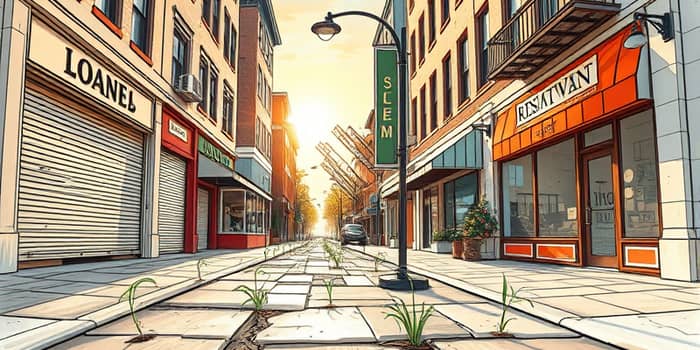
As the U.S. economy navigates the aftermath of pandemic relief, communities and businesses face a stark reality: bankruptcy filings have jumped sharply in retail and hospitality, reshaping the landscape and demanding innovation for recovery.
The overall U.S. bankruptcy filing rate rose 13.1% year-over-year, reaching 529,080 cases in the 12 months ending March 31, 2025. Business bankruptcies alone climbed 14.7%, from 20,316 to 23,309 cases, underscoring a broad commercial strain. This shift reflects the end of stimulus programs, persistent inflation pressures, and rising interest rates that have made debt burdens more difficult to service for many enterprises.
Moreover, filing patterns reveal a deeper story. Chapter 11 reorganizations for large businesses dipped slightly in April 2025, but a 4% increase in Subchapter V small business elections highlights that smaller operators are increasingly turning to structured debt relief. Despite filings remaining below post-Recession highs, the current uptick signals a pivotal moment as pandemic-era lows give way to renewed financial scrutiny.
Physical retail has become an epicenter of distress. Industry analysts estimate up to 15,000 brick-and-mortar stores will close in 2025—more than double the prior year’s 7,325 closures. Even legacy brands are not immune: Joann Fabrics is shuttering all 800 locations, Macy’s has announced 66 store closures this year with 150 by 2026, and chains like Party City and Rue 21 have joined the bankruptcy roster.
These trends stem from overexpansion fueled by aggressive private equity investments, unsustainable debt accumulation, and the relentless rise of e-commerce. Consumers now demand seamless digital experiences, convenience, and lower prices, leaving many traditional retailers struggling to adapt. Urban and suburban shopping centers are dotted with empty storefronts, underscoring the need for rapid adaptation and innovation.
The hospitality sector, particularly restaurants and service providers, has felt a parallel shock. In the first half of 2024, services accounted for 28% of all large corporate bankruptcy filings, with restaurant bankruptcies peaking at their highest levels since the pandemic began. Many national chains earning over $20 million annually have found emergency loans unsustainable, leading to cascading defaults and closures.
Persistent wage and input cost inflation, labor shortages, and a consumer pullback on discretionary dining have eroded margins. Delivery apps, while offering alternative revenue channels, have also intensified competition and fee structures. Suppliers, landlords, and local economies bear the ripple effects as vacancies mount in once-bustling districts.
While the current environment is daunting, there are clear paths to resilience. Companies that survive and thrive will be those that embrace omnichannel retail strategies, focus on lean cost structures, and innovate customer experiences. Practical measures can help stabilizing firms navigate turbulence and position for growth.
The wave of bankruptcies in retail and hospitality is not an inevitable end but a clarion call for transformation. Businesses that reimagine their value propositions, streamline operations, and forge genuine connections with customers will carve out new opportunities. Local stakeholders—from community organizations to investors—can play a critical role by fostering collaboration, sharing resources, and championing innovation.
Delaware and New York courts are witnessing heightened restructuring litigation, and professionals across disciplines are developing creative solutions to preserve jobs and revitalize assets. Whether you are a retailer, restaurateur, supplier, or policymaker, the moment demands action—an embrace of agile mindsets and a commitment to sustainable practices.
Brick-and-mortar is not dead, but its future relies on pragmatic optimism. By learning from recent closures, adopting best practices in cost management, and committing to customer-centric experiences, businesses can navigate this crisis and emerge stronger. The retail apocalypse may feel overwhelming, but within it lies the potential for renewal, community uplift, and a reinvigorated marketplace for all.
References













